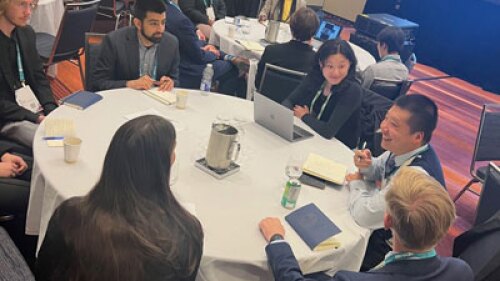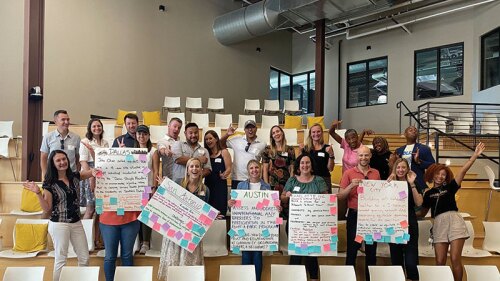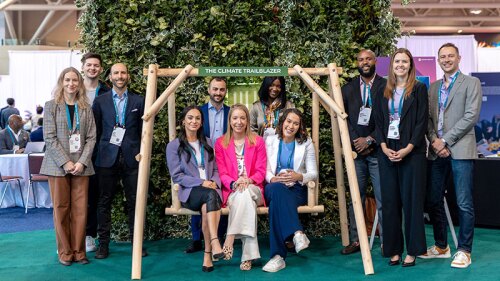By Katharine Burgess
The Landscape Architecture Foundation (LAF) celebrated its 50th anniversary in June by hosting a summit on the future of landscape architecture. More than 700 landscape architects gathered in Philadelphia to hear dozens of industry leaders share “declarations” on where landscape architecture is headed over the next 50 years. The declarations were inspired by the very first “Declaration of Concern,” drafted during LAF’s founding in 1966 when notable landscape architects—Ian McHarg, George Patton, and Grady Clay among them—took a stand on the relationship between the built and natural environments.
Stating that the “landscape architect is essential in maintaining the vital connection between man and nature,” the original declaration focused on the environmental crises of the 1960s and urgently called for landscape architects and others to address them.
“We are concerned over misuse of the environment and development which has lost all contact with the basic processes of nature,” wrote LAF’s founders. “Lake Erie is becoming septic, New York City is short of water, the Delaware River is infused with salt, the Potomac River with sewage and silt. . . . All too soon, life in such polluted environments will be the national human experience.” The statement was made before much of today’s environmental regulatory protection was put in place, with the U.S. Environmental Protection Agency established four years later in 1970.
Fifty years later, today’s leading practitioners are once again addressing environmental crises, focusing on climate change, water conservation, and environmental management in developing countries. Summit participants spoke about global trends of increasing urbanization and the landscape architect’s responsibility for creating vibrant and inclusive public spaces in cities. Today’s professional environment also was a key theme, with a focus on the need for collaboration across design disciplines and the cultivation of more diversity in the landscape architecture profession. Yet others spoke about the historic pillars of landscape design such as culture and beauty, urging practitioners to not forget these priorities in the face of other pressing needs.
Numerous ULI leaders participated in the summit, including ULI Global Chief Executive Officer Patrick L. Phillips, Global Trustee Marilyn Jordan Taylor, Jacinta McCann, and Kona Gray, the LAF board president. All offered visions of how landscape architecture has evolved in the past 50 years and priorities for the future.
Taylor, dean of the University of Pennsylvania’s School of Design and ULI chairman from 2005 until 2007, opened the conference with a welcome to Philadelphia. Beyond celebrating the summit’s urban setting, she encouraged participants to think big and focus on global land use and design challenges, stating that “we will not succeed without fresh thinking,” and “we cannot shrink from responsibility for the urban.” She also discussed the need to collaborate across professions, particularly emphasizing the need for landscape architects and scientists to work together as allies.
Gray compared the original LAF declaration, which was written in 1966 by six white men, to the diversity of perspectives and backgrounds of the summit’s participants and attendees. According to Gray, the conversation among landscape architects has broadened to include a global perspective and an increasingly connected world. The historic conversation was “all about the American landscape,” offering a sharp contrast to the global impact and business practices of today’s leading landscape architects. Gray encouraged the audience to contribute to the event, stating that “we really want you to be bold and provocative. Challenge things. Be critical. . . . We are here to shape the future, and we want all of you to have a voice in that process.”
Phillips was among the conference participants, speaking on a panel of partner organizations that can increase the capacity of landscape architects. “The values and ethos of landscape architects are closely aligned with those of ULI: an interdisciplinary approach, a wide-ranging attitude as to how land use problems get solved, and an appreciation for how natural, cultural, social, and economic factors interact to create the built environment,” Phillips said. “Landscape architects have long played key roles in ULI’s leadership—our current mission statement was largely written by ULI life trustee Joe Brown, a landscape architect.”
McCann, an executive vice president at AECOM and leader of the firm’s design, planning, and economics practice, declared that the next 50 years are likely to be seen as “the era of the bridge.” “The era of building in isolated silos is decisively over,” she explained, focusing on the need for “triple-bottom-line planning” and “new ways to build healthier places for people that, at a base level, do not harm, but beyond that, steward the environment.”
The two-day conference included one day composed largely of declarations, and one day of thematic panels, which together led to what Phillips described as “a rich discussion and thoughtful dialogue about the future.” The Landscape Architecture Foundation plans to preserve the materials written for the summit through an upcoming book. For more information on the 2016 LAF Summit, go to https://lafoundation.org/news-events/2016-summit/.
Katharine Burgess is director of ULI’s Urban Resilience Program.




